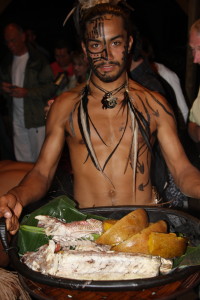Four pillars of essential travel that’s actually worth it for everyone involved
We all have those friends who go on vacations and come back with photos and some souvenirs, who invite you over to dinner and share one or two stories about their trip, along with a few photos, and that’s the last you’ll ever hear of it. Those friends that seem to travel with ease, who come back from their vacations with a tan, but with the same worldview. Those friends that squeezed 341 activities into their trip, but obviously haven’t stopped to think about what it meant—not to them, and certainly not to the local population.
Yesterday’s travel industry is full of excesses and senseless, high-calorie, fast-food style travel for the masses that simply wasn’t serving any greater purpose other than profit—usually at the expense of the rugged and delicate beauty of the very destinations and people that it was exploiting.
In an industry that has pushed ecosystems to the brink, while we are all reawakening to what travel can and should look like again after COVID, what the world needs now is #wholetravel.
1. The Destination
Travel implies a change in location, or at least the movement between locations. While it is certainly true that travel is traditionally about the destination above all else, I vehemently push back on the notion that someone simply “hasn’t lived” until they’ve visited a specific destination. You can spend all your savings, cash in your bonus checks, redeem your hard-earned miles and fly to your dream destination, only to see throngs of tourists running roughshod over it.
The problem with the book 1,000 Places to See Before You Die is that it sets the reader up for feelings of inadequacy, for unattainable goals, and for disappointment when they get to that destination and see it being overrun by throngs of parasitic tourists, pickpockets, and armed tourist police all upholding a thin veneer of cooperation in a system that’s obviously destroying the destination and its authenticity.
Travel is about so much more than just the destination. Read on for the three additional pillars that make up #wholetravel.
Continue Reading →
 My second Vienna layover (on my return journey) was much more productive. I had arranged for 16 hours on the ground, overnight. So, naturally I made no plans for a hotel since that would just keep me off the streets. I’ll sleep when I’m dead! I have Mimes to catch! So, I spent an entire night, once again with a very cold wind and occasional drizzle, wandering the streets of Vienna with my phone and battery pack. I found Mimes…everywhere. Two spawned right beside me without having been on the nearby/sightings menu. All told, 12 more caught for a total of 16. Sadly, none of them above tier 2 appraisal.
My second Vienna layover (on my return journey) was much more productive. I had arranged for 16 hours on the ground, overnight. So, naturally I made no plans for a hotel since that would just keep me off the streets. I’ll sleep when I’m dead! I have Mimes to catch! So, I spent an entire night, once again with a very cold wind and occasional drizzle, wandering the streets of Vienna with my phone and battery pack. I found Mimes…everywhere. Two spawned right beside me without having been on the nearby/sightings menu. All told, 12 more caught for a total of 16. Sadly, none of them above tier 2 appraisal.


 Kangaskhan: Well, having just 3 full days and nights in Australia, I was a little worried
Kangaskhan: Well, having just 3 full days and nights in Australia, I was a little worried
 The island has been stripped bare of most of what you would expect in terms of fertility for a volcanic Pacific island. Runoff of waste and silt have destroyed the nearest reefs. Yet the fish here are the freshest you can imagine. Don’t make the mistake of ordering other meats. They simply aren’t worth it. If you do, you’ve wasted a meal. The best way to eat on the island is to go for a dinner show at Te Ra’ai and to enjoy a feast prepared in an Umu. The hosts of this authentic and heartfelt evening will have been preparing a feast all afternoon. Baked slowly by hot volcanic rocks and steamed in banana leaves in an underground pit for hours, you will indulge on seafood, fresh fruits and vegetables lovingly shared between the hosts and guests. Many Easter Island itineraries only spend two nights on the island…that’s just two dinners! Give yourself more time just for the sake of good eats.
The island has been stripped bare of most of what you would expect in terms of fertility for a volcanic Pacific island. Runoff of waste and silt have destroyed the nearest reefs. Yet the fish here are the freshest you can imagine. Don’t make the mistake of ordering other meats. They simply aren’t worth it. If you do, you’ve wasted a meal. The best way to eat on the island is to go for a dinner show at Te Ra’ai and to enjoy a feast prepared in an Umu. The hosts of this authentic and heartfelt evening will have been preparing a feast all afternoon. Baked slowly by hot volcanic rocks and steamed in banana leaves in an underground pit for hours, you will indulge on seafood, fresh fruits and vegetables lovingly shared between the hosts and guests. Many Easter Island itineraries only spend two nights on the island…that’s just two dinners! Give yourself more time just for the sake of good eats.











